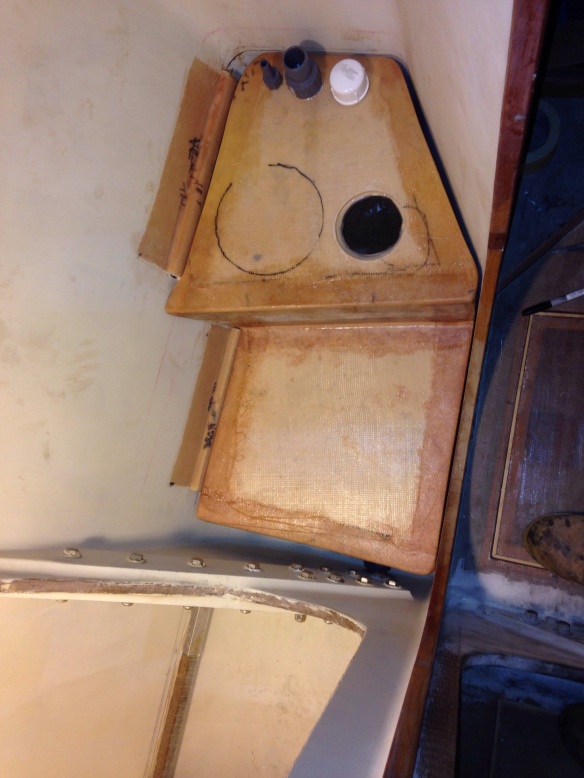The bathroom is never big enough, right? Because our hull bottom is so skinny, the head compartment is cramped and every inch of space needs to be used efficiently. So what goes under the toilet – well, the holding tank makes sense. Thank you Mike L for insisting on that one :). One wants the “black water” tank as large as possible for lazy cruising days, so as to minimize trips to the dreaded pump out station. Rather than buy a expensive, too small tank, we made one that fills the space available. First the blank canvass …

Now line it with plastic, but NOT like this. Using the loose bag produced nasty ripples along the bottom. Had to cut those out and redo with form-fitting plastic tape instead applied to the hull shape.

The L shape means the tank is both under your feet and under the toilet base.

That whole unit lifted out after some prying, and the top pieces were made on the vacuum table. Along with some heavier laminations for the floor and shelf that will sit just above the tank.

Rather ugly for my first ever tank build, but it held water under testing.
The outlet to the sea is at the bottom, while the inlet / dock pump out, the breather vent, and a spare clean out port sit on top. Rather than installing an expensive and wire-consuming monitor system, there’s a visual level gauge on top – a window we won’t inspect too closely!

After sealing it all up, the tank slides in place. The hull-facing wall is inset 3/4″ to allow for a bonded-on high density bolting flange (on the wall, not the tank) that will take the weight of the toilet and user, as opposed to actually pushing down on the tank.
The black pen circle is where the toilet will sit on the shelf just above this tank, but the toilet is not connected to the tank. An exit hose runs from the back of the toilet, up through a pump and a loop up above the waterline, then down in to the tank. The good news is this design means no waste stays in the pipes, which is usually the cause of nasty smells. We’ll see the head installed and the shower floor come together in the next post, and maybe some cardboard mockups of vanity counter / cabinets.
Back on deck, we hung the near finished boom in place and set up the Delta Vee main sheet. Well… The long-tiller steering isn’t going to clear so it makes sense to build a linkage steering system. Messed about with the geometry today until getting the right pivots and control arm lengths.

The steering action is fast and the tiller throw much shorter; this is a much better solution than the first, including a nice way to attach an electronic tiller pilot independent / redundant from the wind vane system. Farrier’s plans call for all this gear to be inside the aft cabin, but I saw that on a completed F39 and it really interferes with the cabin living space. Other owners would not like the steering gear exposed on deck, but I like the simplicity and obvious inspection ability of the gear in plain sight. Thinking of using a flanged rudder bearing to anchor the tiller pivot, and some combination of carbon bars and stainless steel rods & ball joints for the linkage. Type 304 SS ball joints are easily found – thinking we’ll use those and carry extras vs. hunting for rare type 316 SS ones. Any comments back about that?



















